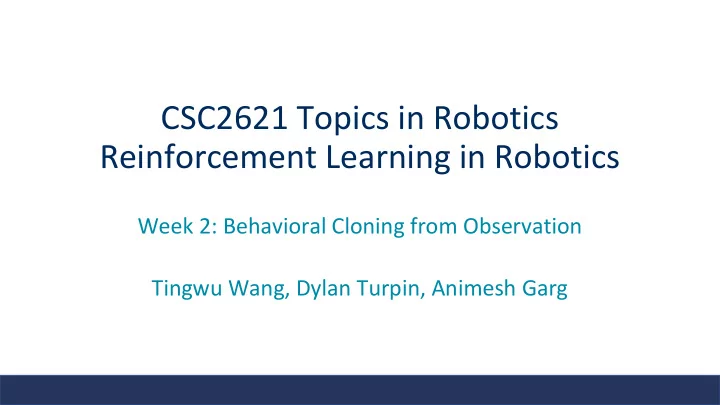

CSC2621 Topics in Robotics Reinforcement Learning in Robotics Week 2: Behavioral Cloning from Observation Tingwu Wang, Dylan Turpin, Animesh Garg
Agenda • Background • Problem Setting • Behavior Cloning / Dagger • Generative Adversarial Imitation Learning • Motivation • Behavior Cloning from Observation • Algorithm • Results • Discussion
Problem Setting • Imitation learning • Other names in different contexts: • Learning from demonstrations / Apprenticeship learning • Input : • Expert’s perfect trajectories {(s_t, a_t)} • Output : • A policy network p(a_t | s_t) • Goal : • Can our agent be taught to reproduce the skills to solve a given task? • Why not reward / Why not use human designed rules? • Hard / not safe / not generalized
Behavior Cloning / Dagger • Treat it as a regression problem • A policy network • Input: s_i • Output: a = p(a_i | s_i) • Find the policy parameterized by phi that fits the expert data • How is the “dataset” {(a_i, s_i)} generated? • Two different problem settings
Behavior Cloning / Dagger • Behavior cloning (BC) • Setting A • Ask an expert to generate the expert dataset . • The agent direct regresses on the expert dataset . • Train on expert’s state distribution . • Dataset Aggregation algorithm (Dagger) • Setting B • The learner samples the states {s_i}. • Then ask the expert to produce the correct actions {a_i}. • Repeat • Dagger: Train on learner’s state distribution . It has a more powerful / kinder expert.
Generative Adversarial Imitation Learning • Goes back to Setting A • Behavior cloning is good enough when: • Large amounts of data • Lower dimensional environments • Compounding error • Inverse reinforcement learning (IRL) • Learns a cost / reward function that prioritizes entire trajectories. • Then learns the policy as a RL problem. • Mathematically proved that it introduces smaller compounding error.
Generative Adversarial Imitation Learning • Generative Adversarial Imitation Learning (GAIL) • Learn the reward function using GAN (Generative Adversarial Network) • Discriminator assigns reward of 1.0 to expert’s (s_t, a_t) • Discriminator assigns reward of 0.0 to learner’s (s_t, a_t) • Process • Learner generate new trajectories {(s_t, a_t)}. • Discriminator trains on trajectories of the learner and expert. • Discriminator assign rewards to learner’s trajectories {(s_t, a_t)}. • Learner updates policy network.
Motivation • BC / GAIL / Dagger • They all requires the access of the actions, which is not the case when: • Imitation learning from motion captured data • Virtual Reality Teleoperation • Noisy data / model mismatch / retargeting • Instead of expert’s perfect trajectories {(s_t, a_t)} • Input : • expert’s perfect trajectories without actions {(s_t)}
Behavior Cloning from Observation • The idea of behavior cloning from observation (BCO): • If the actions won’t come from the expert, then the learner must come to infer the actions • Inverse dynamics • Forward dynamics: • s_t ← f(s_{t-1}, a_{t-1}) • Inverse dynamics: • a_{t-1}t ← f(s_{t-1}, s_t) • Essentially • Inverse dynamics + BC • BCO (alpha) variant
Results • Comparison on 4 environments
Discussion • Pros: • Proposed to solve a problem of a new setting. • Cons: • Could have a more comprehensive result sections • Right figure from [1] • Below figure from [2] [1] Wang, Tingwu et al. “Benchmarking Model-Based Reinforcement Learning.” ArXiv abs/1907.02057 (2019) [2] Fujimoto, Scott, et al. "Off-policy deep reinforcement learning without exploration." arXiv preprint arXiv:1812.02900 (2018).
Discussion • Cons: • Some of the claims are not supported by empirical results nor theorems. • Missing baselines and perhaps limited novelty [3]. [3] Merel, J., Tassa, Y., Srinivasan, S., Lemmon, J., Wang, Z., Wayne, G., & Heess, N. (2017). Learning human behaviors from motion capture by adversarial imitation. arXiv preprint arXiv:1707.02201 .
Recommend
More recommend